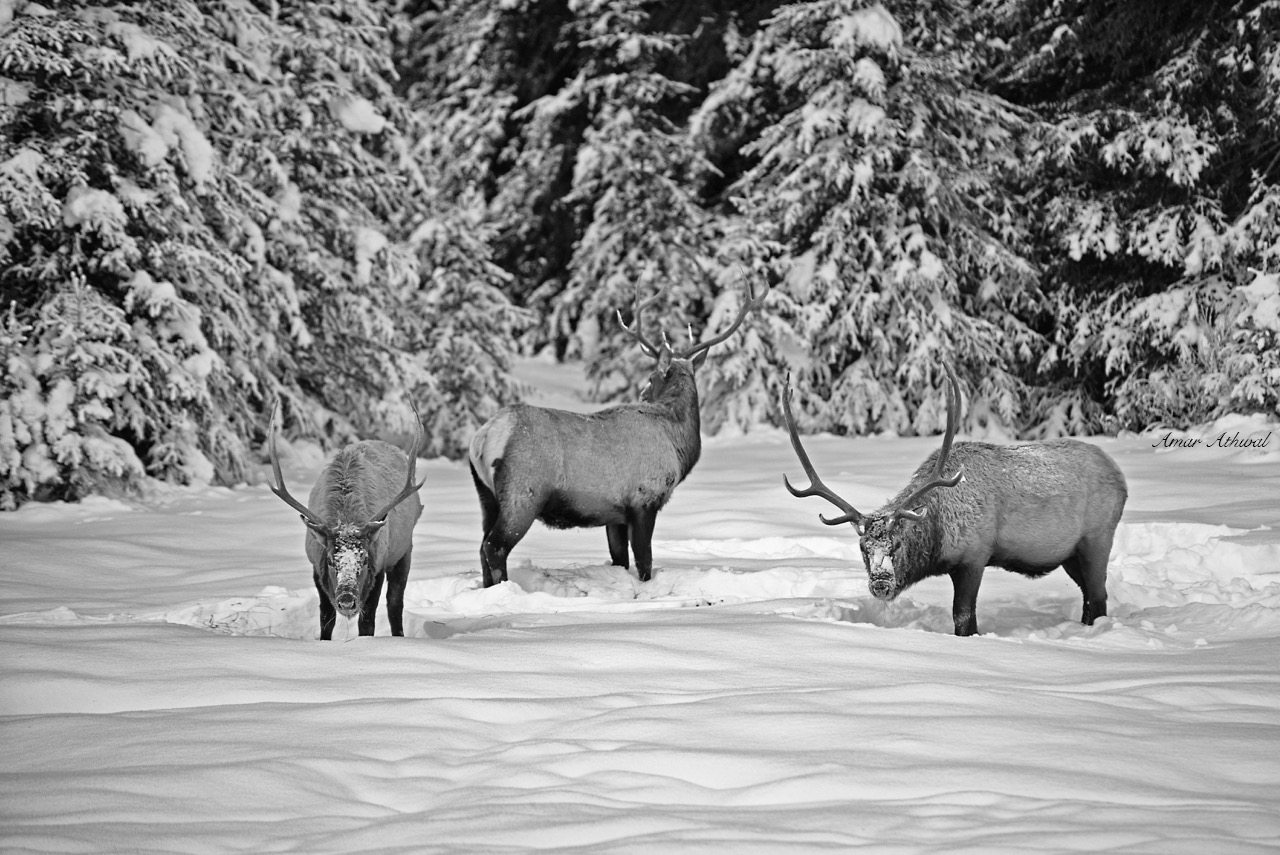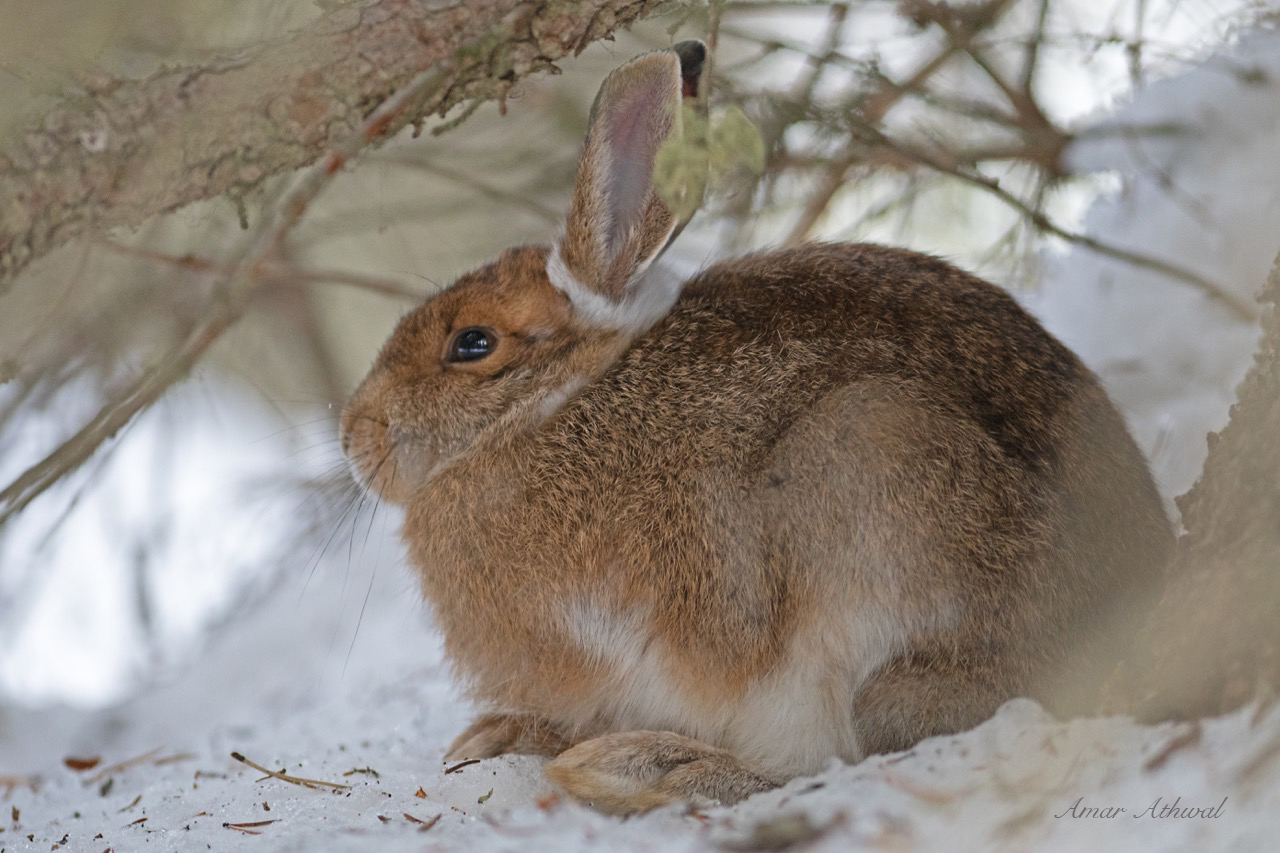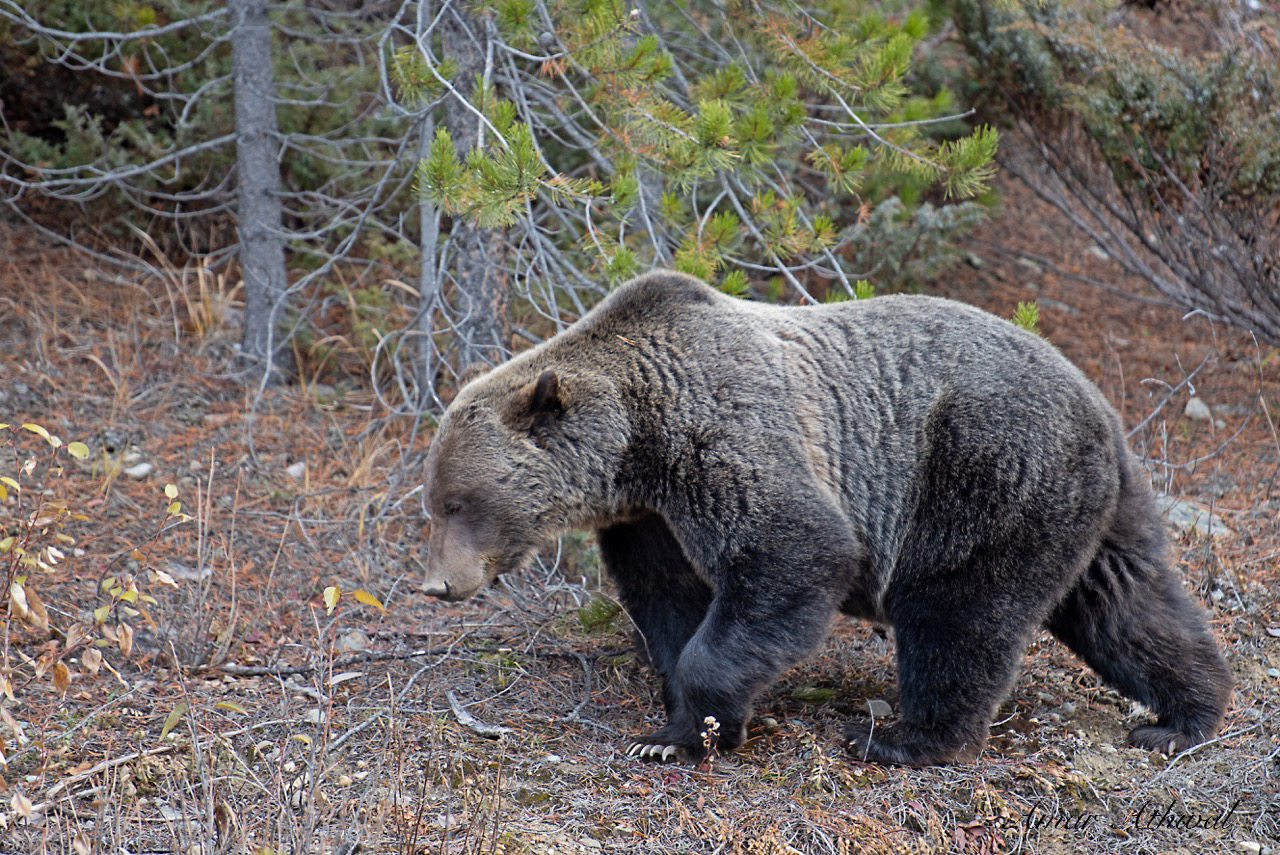I was tracking birds to take pictures of in the forest, when I heard sounds from below. It was this beautiful short-tailed weasel searching for food.
Grizzly
I can still see the frighten look on the adult female grizzly face I saw one early morning in June. I have known F160 since 2012 when she was a year old, life was a lot simpler then, with her mother in her 20s having lots of life experience and doing a great job looking after her three cubs. In June the eight years, was in a bad place, bad side of the fence, and middle of the Trans-Canada Highway. F160 was looking for a way out, kept changing direction, running back and forth. I was worried for her and even more so when I could only see one of the two cubs she was with just a few days before. I called Banff’s Dispatch, they were already made aware and help was on its way. As I was talking I saw the help, replied back, I hope the other cub is safe and I left the area. Later that day I learned the family was back on the good side of the fence. About ten days later the other cubs was spotted with vehicle related injuries, with a broken back right leg. She was euthanized the next day.
Banff National Park has come a long way, keeping wildlife away from the busy road, with fences, wildlife crossing and colleague working to keep the wildlife safe. Bears are pretty amazing animal, very curious, which is great when searching for food. No one knows if it was the search for food or running from a large male grizzly that got them going over the “cattle guard” and then onto the highway. The hard part always is getting wildlife back to the good side of the fence on their own, physical options are being incorporated. But even today, the best hope comes in the form of human, opening the gates along the road and forcing the wildlife in their direction. The cub is survived by its mother and its sibling, hoping to see them for many more years.
Black Bear
I came across this black bear sitting down and enjoying buffalo berries.
Grizzly
Just under two hours were left before sunset, I decided to go for a drive. Middle of a straight way, several vehicles were parked on both sides of the road. Folks were out of the vehicles and looking up the slope of the mountain. I stopped and asked what they were looking at, black bear they said and pointed. I looked in the direction and then quickly pulled out my binoculars, it was not a black bear but a large grizzly. I told the crowd who were looking or trying to locate the bear and taking pictures with all type of cameras, even when it was about 400 meters away. As soon as they heard me, they asked if it was the “boss”, I said yes it was M122. Making his way up the slope of the mountain, I started wondering why. They do not use up all that energy for no reason. It was not an area where it was going to go over a pass, nothing to dig up and too early to go up and looks for moths under the rocks. Perhaps there was a kill up there, the wolf pack have gone up there and cougars hunted in the area. We would never know if he found anything, but he sure made lot of visitors to Banff happy that evening, as they observed with their eyes, binoculars, cameras and with a scope one gentleman pulled out for others to use.
Red Fox
The red fox had found something to eat, a frozen bird that looked to be hit by a vehicle few days ago. It was covered with dirt and snow, not much of a meal, but a start to the morning meal. Normally I just see the tracks of the fox, hunting near and away from the road. This cold morning the fox was where I was passing through, the warm morning light was starting to streak through the forest. With each hour the temperature would go up, requiring less energy to stay warm. For this fox like any other wildlife, it’s all about instinct in deciding how much food is needed. If they eat too less, it makes it harder to survive and harder to catch their prey. If they eat too much, they then become too slow to get away from the predators. Most of us humans have stopped paying attention to our bodies, even after a big meal we’ll somehow will find space for that slice of chocolate cake.
Elk
Relatively speaking, it started out easier for the elk this winter. Not as cold and less snow on the ground. They still had to eat the same less nutritious food, no greens in the winter. But less snow to move aside to get at the food and less energy needed to get through the milder days and nights. But all that changed, snow storms started to come through and February brought with it much colder temperatures. Just like these three bulls, they have to spend more energy moving lots more snow to get at the less nutritious food and as well, losing lots more energy to survive the colder days and nights. Until spring arrives, they will be getting weaker, while their predators get stronger.
Elk
How time flies, it's that time of the year again. On Saturday, February the 2nd I'll be doing a slideshow presentation at the Cave and Basin NHS. Going over some of my favourite nature pictures from 2018 and the stories that go along with them. For $4.90 come spend couple of warm hours, from 7 to 9pm, sitting back and looking at flora, fauna and landscapes photos from the past year.
Red Fox
I’m pretty sure it was this red fox I came across during the summer season. Near a parking lot, eating something with people just meters away from it taking pictures. People meters away from wildlife are a national park is a red flag. I got closer in my car, popped out to have a look what it was eating, it was human food. Back in my car, got even closer made loud noise to scare off the fox. People were not happy with me, I then explained what human food can result in. Sharing the story about members of a wolf pack getting their first human food meters from the spot. Becoming food conditioned, resulting in two wolves being put down and the packs new litter of six not surviving the summer. The look on people’s faces became more understanding, as I picked up all the bread (a bag worth)crumbs left next to an electrical box. The fox is doing well, spotted it few times hunting for its natural food.
Coyote
On a sunny morning I watched this and two other coyotes pass by, one stopping to hunt. He tried few times but had no luck, then decided to catch up with the other two.
Grizzly
Had an early morning adventure, small hike after taking sunrise pictures. I was back in the Bow Valley, when I saw a large male grizzly on the edge of the forest. It was the famous Banff grizzly M122, who I have seen more toward the end of the season this year. Dispatch had been informed of M122 being in the area, soon after colleagues dealing with human-wildlife conflict arrived. Weekend mid-morning during the fall season tend to be quiet, but there were workers in the area and everyone wanted to make sure the grizzly passed them safely. The bear was given lots of space, he decided the pace he wanted to move at. And boy did he take his time, stopping to dig, moving in and out of the forest, crossing the road several times, he was not in a hurry. As if he was enjoying the VIP or should I say VIB treatment.
Grizzly
Few big male grizzlies are still walking around in the mountains. Relatively speaking the warmer temperatures has to be playing a role and if food is out there, the big grizzlies are going to find it and can easily fight other predators for it.
Snowshoe Hare
When the snow is on the ground, I come across so many snowshoe hare tracks, but rarely see them. A few weeks back, I came across this little one, hiding under low branches. Taking its time changing from its summer colours to the its winter colours. Without its white winter coat, it would be easily spotted by its predators, giving it a short life.
Red Fox
Red Fox traveling along the road one morning, who was stopping every now and then to hunt for breakfast.
Grizzly
It was a cool evening and I was waiting in my vehicle for a large grizzly to come out in the open. He was still few hundred meters away and was taking his sweet time. With the window down I could feel the cool breeze every now and then, looking out, listening and wondering if griz was going to come out before the dark. May of 2011 was the first time I saw this male, he was a skinny young male walking along a road in a another national park. Two years later I saw him again, he was filling in nicely in terms of weight and his role in the mountains. In the last few years I have seen him several times, Banff NP is his main home, his range covers at least two more parks that I'm aware of. By chance last year I saw him with at least three females, for one female he covered 60 kms in two days to mate with. This fall from my eyes he looks to be easily over 600 pounds and is making the most of his size on the landscape. My waiting paid, he stayed on route and gave me a minute to see him before he was out of sight again. He should be close his time for deep sleep for the winter, if he isn't already. Hoping to see him again next spring.
Elk
The rut season is over, the elk are taking advantage of the mild weather to gain weight. Particularly important for the dominant bulls. who lost 20 to 30 percent of their weight battling other bulls. The more weight the bulls gain, easier it will be getting through the winter.
American Marten
The american marten went up the tree when I came across it, a way it protects itself. Once realizing there was no danger, it came down to the ground and ran away.
Grizzly
On my way back from a great outing, where I was exploring and taking pictures, I came across this large grizzly walking near the road. In his full fall weight, all ready to go into a deep sleep to pass the winter. Every now and then he would stop to dig for some calories and then continue his merry way.
Moose
Moose like other wildlife have been dealing with more snow and cooler temperatures much earlier this year. Even with warmer days coming up tomorrow, much of their food has fallen to the ground. The moose will start eating twigs sooner then later.
Elk
The decibel level of elk bugling is 90 dB at 4 meters, lawnmower and food blender are two items that have similar sound levels. I have heard the bugling as far as 1 km away, with elk's larger ears, they would be able to hear the bugling from even further distance. this is important for the females who want to mate with a stronger male and help keeps weaker males away. Over 85 dB can lead to damage for human ears, another reason for us humans to keep our distance from wildlife. The recommend safe distance from elk i at least 30 meters. at that distance the bugling sound level comes to 72.5 dB. Close to the sound level when you're using a vacuum.
Elk
I came across this bull elk during a snow storm. I saw him with a small harem, away from any other males that might challenge him. He was still bugling, letting others know the harem was his.



















